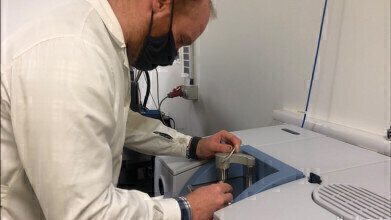-
 Identifying aging mosquitos (Credit: University of Glasgow)
Identifying aging mosquitos (Credit: University of Glasgow)
News & Views
Step-change in Malaria Vector Identification has Impact Potential for other Diseases
Mar 23 2022
In a study to quickly identify aging mosquitos that are capable of transmitting the deadly malaria parasite, an international team led by scientists at the University of Glasgow’s Institute of Biodiversity Animal Health and Comparative Medicine (IBAHCM) and School of Chemistry, the Ifakara Health Instititute (IHI) in Tanzania and the Institut de Recherche en Sciences de la Santé (IRSS) in Burkina Faso, turned to the use of the use of infrared spectroscopy and artificial intelligence (AI).
With the infrared light providing information on the chemical composition of individual insect’s cuticles, the chemical changes of ageing mosquitos were identified using an AI algorithm. The scientists validated their predictions on wild mosquitoes with current methods, achieving similar results.
Doreen Siria, lead author from IHI, said: “Only mosquitos that live long enough to develop malaria – around ten days – can transmit the disease, so knowing the age of a mosquito can help inform the risk of disease.”
Previous identification methods via complex dissection of female mosquitos’ ovaries, was an expensive, time-consuming process that couldn’t be done at scale, she added.
“This AI-driven infrared light technology requires a spectrometer currently costing around $20,000, which can be used as part of existing, routine malaria vector surveillance and offers a way to quickly establish if current intervention measures to reduce mosquito numbers in the wild are working, something which isn’t currently possible,” commented Roger Sanou, lead author from IRSS.
Dr Francesco Baldini, from the IBAHCM, said: “With this infrared technology, we have developed a tool which could be adopted within current mosquito control plans; has the potential to be scaled up for use across different areas; and would greatly help in testing new products and solutions against diseases transmitted by mosquitoes.
“We envision this approach could also be applied to other vectors and vector-borne diseases, from filariasis and chikungunya, to sleeping sickness and Zika; and could be used to evaluate the attempts to limit the expansion of invasive mosquito species across Europe and the United States”.
The resulting computer models can be adapted and implemented in the field for vector surveillance.
Simon Babayan, from the IBAHCM, said: “As these technologies become more accessible, we will move towards instantaneous data collection and analysis directly within, and potentially by, the communities that need to act on such information the most”.
Mario Gonzalez-Jimenez, from the School of Chemistry, added: “This work has shown that the same algorithms that allow us to recognise faces and objects in a photo are also able to identify the ways in which chemical compounds show their presence in a spectrum, even in samples as complex as a living being. We are witnessing how the use of AI is making possible chemical analyses that were unimaginable just a few years ago.”
The study was published in Nature Communications.
More information online
Digital Edition
Lab Asia 31.2 April 2024
April 2024
In This Edition Chromatography Articles - Approaches to troubleshooting an SPE method for the analysis of oligonucleotides (pt i) - High-precision liquid flow processes demand full fluidic c...
View all digital editions
Events
Apr 24 2024 Jakarta, Indonesia
Apr 25 2024 Istanbul, Turkey
Apr 28 2024 Montreal, Quebec, Canada
May 05 2024 Seville, Spain
InformEx Zone at CPhl North America
May 07 2024 Pennsylvania, PA, USA

















